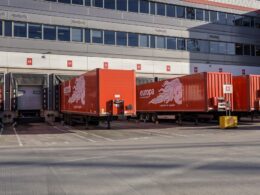In the last few years, we’ve seen more and more natural disasters striking all around the world. And while most of us rush to blame nature for it, the sad truth is that we’re the responsible ones. We’re the ones speeding up the effects of global warming, and it’s on us to stop it. If we choose not to take action, our beloved planet might become uninhabitable much sooner than we all hope. Of course, everyone has to do their part, and today, we’ll tell you how you can do yours. So, let’s talk about how to reduce carbon footprint in logistics.
What is Carbon Footprint, and How Can We Measure It?
Before we dive into how you can minimize your carbon footprint and fuel a greener future, we need to look at the basics. So, what is carbon footprint in the first place?
It’s the total emission of greenhouse gasses that you release through both direct and indirect activities. All people, companies, and even products in the world have it.
Now, measuring it is a bit more tricky than we might want it to be. In essence, you have to note everything that causes these emissions. Some of the most significant pollutants that you’ll need to keep track of are:
- Electricity consumption
- Means of transport
- Fuel sources
- Waste production
- Materials you use
Once you figure out which of your activities lead to the release of GHGs, you can calculate your carbon footprint. And you do so by multiplying emission factors by the data you’ve gathered.
Once you see how big of an impact your company has on global warming, the chances are that you’ll want to be a bit more mindful about it. It might encourage you to make changes to the things you do and how you operate to bring the adverse effects on the environment down.
What Can the Logistics Sector Do?
Logistics are a big part of the supply chain, and they have a significant impact on worldwide distribution. On top of that, recent eCommerce growth in popularity accelerated growth in the sector. And, of course, with so much development, we can only expect the logistics carbon footprint to go up.
For that reason, we can’t afford to wait. We have to introduce sustainable changes to the industry as soon as possible if we don’t want it to ruin the planet we live on.
Luckily, going green brings plenty of benefits to the game. Companies like relosmart.asia, which recently turned eco-friendly, say that their money savings are through the roof after the transition. Here’s what you can do if you want to join in the transformation and help reduce your carbon footprint in logistics.
Making Warehouses Greener
By the nature of things, supply is constant, while demand can be unstable. We’ve all been in a situation where all our customers are craving for a certain something one day, and the next, it seems that no one wants to have anything with it. Now, that’s why every supply chain has a warehouse to store extra products. It brings you peace of mind as you know you’re all set for it if the demand suddenly increases.
The problem with warehouses from the environmental standpoint is that most of them are climate-regulated. So to keep the temperature where you want it, you have to use air-conditioners, and they’re in no way eco-friendly. However, there is a way to keep the place cool without harming the environment.
The first step would be landscaping the area surrounding your warehouse. Plant plenty of trees all around, and not only your storage space will feel cooler, but it’ll also look way better. Even more critical is insulation. It will keep the temperature stable for longer, meaning that your AC won’t have to work as hard to do its job. And if you want to take things even further, replace all your lights with LEDs. They consume as much as 80% less energy while still giving you plenty of lighting. Making warehouses more environmentally friendly will help reduce carbon footprint in logistics.
Using Eco-Friendly Modes of Transport as a Way to Reduce Carbon Footprint in Logistics
Not every way of transporting goods will harm the environment the same. As we all know, ocean freight and air freight are the modes of transport responsible for the high logistics carbon footprint the most. That said, DB Schenker and Lufthansa Cargo offer CO2-neutral air freight, and it’s a step in the right direction.
When it comes to road transport, it certainly harms the planet less, but it’s still far from good for it. Hence, the best option we have at the moment is rail transport. It produces far fewer emissions than any other mode of transportation, so be sure to go for it if possible.
Switching to Green Suppliers
We could bring the greenhouse gas emissions in logistics way down if we all switch to green suppliers. During the manufacturing process, pretty much all producers process materials. And the more they process them, the more carbon dioxide and other GHGs they release. Now, depending on the type of materials they use, the amount of energy they use, and the amount of waste, the impact on the environment can be higher or lower.
To ensure sustainability, try to avoid suppliers who heavily process their products. Instead, go with ones who prefer using raw materials, as these harm the environment much less.
Of course, no matter what they make, all producers can reduce their carbon footprint by reducing fleet size and making efficiency gains. If you don’t want to switch suppliers, check with them if they’re doing anything to become green or have plans for it.
Reducing Energy Usage and Waste Production
Energy usage and waste production are standard parts of all logistics processes. You can’t do your job without it. However, that doesn’t mean that you can’t reduce them. Here are three simple steps to make your company a bit more eco-friendly.
- Learn not to waste energy and train your employees to do the same
- Reduce packaging (especially if it’s plastic)
- Limit the amount of paperwork your company produces (digital copies of documents are as good these days)
Conclusion
Undoubtedly, more and more companies will want to learn how to reduce carbon footprint in logistics as time progresses. International laws make businesses go eco-friendly, and you shouldn’t wait for it to become a norm. Consumers prefer companies that care about nature already, and that trend will only rise. So if you want to stay ahead of the curve, start your transition right away.













